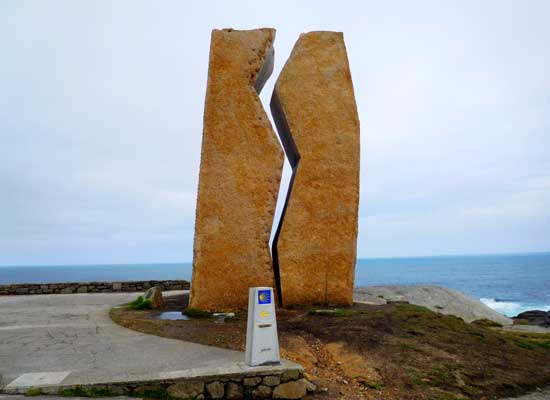Step by step on The Way of Saint James
Muxía and Santiago de Compostela
15 June 2018

This morning, we wake up at a leisurely pace to recover a bit from the early starts we had throughout The Way, especially in the past few days.
At 08:00, we take a bus that brings us to Cee and then, with a second bus, we reach Muxía (pronounced Moo-SEE-ah).
Today, the weather is not as nice as yesterday: the sky is cloudy, and the temperature is rather chilly.
Perhaps due to the weather, our first impression of Muxía is that of a grey and remote place.
The first thing we do is head to the information office to get some tips about the interesting sights in town.
The staff member at the desk gives us a tourist map highlighting the area’s attractions and then immediately suggests stamping our Credentials with the Muxía stamp and obtaining the Muxíana. The latter is a document certifying that one has walked the coastal route from Finisterre to this point.
Apparently, the clerk isn’t too strict, as the stamp and certificate are usually given only to those who have the stamp of Lires in their Credential. Lires is a small village along the coast that one must pass through when walking to Muxía.
Despite the woman’s kindness, I stick to my principles and decline the certificate since I didn’t walk this route.
Muxía, like Finisterre, is located along that stretch of the Galician coastline known as the “Costa da Morte” (Coast of Death).
This gloomy nickname doesn’t refer to the landscape, which is actually very beautiful and evocative, but rather to the numerous shipwrecks that have occurred in the waters off this coast.
Over the years, and even in more recent times, this stretch of sea has been the scene of many tragedies: several ships have tragically ended their journeys here due to stormy seas and rocky seabeds near the cliffs.
A more recent event dates to 13 November 2002, when, just a few kilometres from Finisterre, the oil tanker Prestige was involved in an unclear incident, splitting in two.
The crude oil it was carrying caused a black tide that reached not only the Galician coast but also parts of the Portuguese and French coasts, resulting in one of the worst environmental disasters ever to occur in Europe.

Muxía’s main attraction is the sanctuary of Virxe da Barca, located just outside the town centre on a spectacular cliff where mighty ocean waves crash.
A legend tells that the Virgin Mary arrived at this piece of land aboard a stone boat. The miraculous appearance was meant to comfort the Apostle James, who was facing many difficulties in his mission to evangelise the region.
The remains of the boat can still be seen on the same cliff, not far from the sanctuary.
Specifically, there are three large stones known as pedra de Abalar, pedra dos Cadrís, and pedra do Timón—representing the boat itself, the sail, and the rudder, respectively. According to ancient tradition, these stones have supernatural and even healing powers.

In the same area as the sanctuary, there is a lighthouse and a modern stone monument called pedra da Ferida, erected to commemorate the oil tanker tragedy off the coast.
The site is highly evocative and can be admired in its entirety from above, at the mirador do Corpiño, a small hill at the centre of the promontory that offers panoramic views of both the town and its surroundings.
– Now Muxía, with its hinterland, fully reveals to me all the charm and magic of a remote frontier location. –
After a quick snack in a local café, at 14:30, we take a bus directly to Santiago de Compostela, arriving at around sixteen.
We spend the afternoon wandering around the city and end the day with an evening of tapas, sampling them at the counters of various bars in the historic centre, as Spanish tradition dictates.
Tonight, we also immerse ourselves in the lively nightlife of Santiago de Compostela, staying out late—but not too late.
| © Aldo Lardizzone 2020 |  |
CREATIVE COMMONS |


